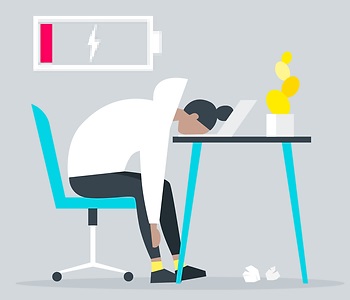Burnout has recently been classified fully by the World Health Organisation (W.H.O.).
It is a condition which comes from stresses in the workplace, and so a change in the person’s relationship with their job is one thing on the list to fix when someone experiences burnout.

=========
Executive summary – key points
The third perfectionism reason is the most likely to cause burnout – attempting to reach someone else’s unattainably high standards. Parents: heed this warning and beware of imposing your own wishes for success on your children. (explained at 33 mins).
Healing burnout:
- Control over work
- Foster a community spirit of appreciation (rather than criticism);
- Find value in the tasks, see the bigger picture and feeling fulfilment due to progress towards the end-goal.
• Manageable workloads.
(Explained at 35 mins)
Webinar summary, at timed bookmarks
mm:ss:- Webinar Timings mm:ss
03:49:- The webinar actually starts at 3min 49sec, into the recording, there is no content before that.
10.05:- W.H.O. diagnostic criteria for burnout:
1) Feelings of energy depletion or exhaustion
2) Increased mental distance from one’s job or feeling negative towards one’s career.
3) Reduced professional efficacy.
75% of employees experience burnout at some point.
50% of staff turnover: Nearly half of HR managers surveyed estimated burnout caused 50% of their staff turnover.
Employers should take note: Millenials and Gen-Z are more likely to suffer from burnout.
20:44:- Performance-pressure curve. Employees are bored if there is not enough pressure. People require enough pressure to produce optimal performance. However, if the employee experiences too much pressure, their performance drops off a cliff.
Burnout severity is classified using a scale: Maslach burnout scale.
Heart disease is prevalent in people who score high on the Maslach scale.
25:30:- 6 causes of burnout:
Lack of control, Unclear job expectations, Dysfunctional workplace dynamics, Extremes of activity, Lack of social support, Work-life imbalance.
32:37:- Curran & Hill measured a 33% increase in perfectionism since 1989
Christina Maslach created the Maslach Burnout Inventory
How to avoid burnout:
- Burnout shouldn’t be ignored – it won’t go away of its own accord.
- Soldiering on will cause burnout to become chronic.
- Build up resilience
- Seek support from your manager
- Confide in someone.
- Improve work-life balance
- Taking breaks boosts wellbeing and also productivity.
- Short breaks, e.g., every 90 minutes: proved in research in 2012.
- Altradian rhythms work in 90 minute cycles.
- Take annual leave
- Outside interests which excite you and bring focus outside work (without over-committing).
- Make sure you are comfortable with your organisation’s values.
- Self-care
- Meditation
If your problems persist – speak to a professional counsellor or your EAP (Employee Assistance Programme).
People can try to work harder when they feel the signs of burnout (e.g., lower productivity), and this can be a vicious cycle which makes the burnout worse.
The employee’s “stress bucket” can become full, and their usual unwind and relaxation no longer clears the stress. The employee can be triggered back to an exhaustion state by any new demands, they are “tired, but wired”.
One burnout cause is toxic perfectionism, which are unattainably high standards. This is not the striving for excellence, which can be healthy, but toxic challenges which are impossible to achieve.
33:00:- Toxic perfectionism and 3 causes of perfectionism:
The third perfectionism reason is the most likely to cause burnout – attempting to reach someone else’s unattainably high standards. Parents: heed this warning and beware of imposing your own wishes for success on your children.
Toxic perfectionism
Perfectionism is a personality trait that involves constantly striving for perfection and refusing to accept anything less than flawlessness.
Perfectionism is not about having high standards – its about unattainable standards.
Recent research suggest perfectionism is on the rise with a 33% increase since 1989 (Curran and Hill).
Psychologists have identified 3 types.
- Self-orientated – where someone seeks perfection for themselves.
2. Other-orientated – where someone holds other people to unreasonably high standards.
3. Socially-prescribed – where someone tries desperately to live up to other people’s expectations.
35:00:- suggested solutions
How employers can minimise burnout
6 ways businessses can reduce the likelihood of their employees burning out (Maslach).
• Giving employees control over their jobs, to the extent this is possible.
• Rewarding and acknowledging good work, either financially or verbally.
• Fostering community.
• Treating workers fairly and equitably.
• Helping workers find value in their work.
• Creating manageable workloads
—
Avoiding burnout 1
Burnout shouldn’t be ignored – it won’t go away of its own accord.
Soldiering on will just cause it to become chronic.
1. Build up your resilience.
2. Seek support from your manager if you feel you’re struggling.
3. Confide in those you’re close to.
4. Establish a healthy work-life balance.
—
Avoiding burnout 2
5. Take regular breaks
6. Ensure you use your annual leave entitlement.
7. Make sure you have interests outside work.
8. Make sure you’re comfortable with your organisation’s values.
9. Engage in regular self-maintenance.
10. Meditation can help with burnout.
11. If your problems persist – speak to a professional counsellor or your Employee Assistance Programme (EAP).
Further information
Contact us using our contact form for a link to the webinar slides and also for the 133Mb MP4 video file of the webinar. It’s often useful to listen to information in a podcast manner, while out and about.
(Admininstrative note: Files are in this folder: Google Drive\Shared\Making-The-Sabbatical-Case)

Leave a Reply
You must be logged in to post a comment.